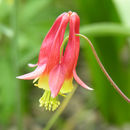en
names in breadcrumbs


Aquilegia canadensis has also been reported from New Brunswick, but the specimen has been destroyed and the species has never been recollected in the province.
Native Americans prepare infusions from various parts of plants of Aquilegia canadensis to treat heart trouble, kidney problems, headaches, bladder problems, and fever, and as a wash for poison ivy; pulverized seeds were used as love charms; and a compound was used to detect bewitchment (D. E. Moerman 1986).
Aquilegia canadensis, the Canadian or Canada columbine, eastern red columbine, or wild columbine, is a species of flowering plant in the buttercup family Ranunculaceae. It is an herbaceous perennial native to woodland and rocky slopes in eastern North America, prized for its red and yellow flowers. It readily hybridizes with other species in the genus Aquilegia.
The plant is 15–90 cm (6–35 in) tall. The fern-like leaves are lobed and grouped in threes, growing from the base and off the flowering stems. The flowers are 1–2 in (2.5–5.1 cm) long and have yellow petals with a red spur and red sepals. They appear in late spring (usually in May and June), nodding on stems above the leaves. The round end of the spur contains nectar, which is sought by butterflies and hummingbirds.[2]
The caterpillars of Columbine Duskywing (Erynnis lucilius) feed on the leaves.
Aquilegia canadensis is a highly decorative plant, valued for its attractive foliage and showy flowers. For this reason it is widely grown outside its native region, in temperate regions of the Northern Hemisphere.
The plant is easily propagated from seed, and blooms the second year from sowing. It is relatively long lived in the garden. It grows well in shade, and in sun with proper moisture.
The cultivar 'Little Lanterns' is half the height of the species.
Native American tribes used various parts of red columbine in herbal remedies for ailments such as headache, sore throat, fever, rash caused by poison ivy, stomatitis, kidney and urinary problems, and heart problems.[3] Native American men also rubbed crushed seeds on their hands as a love charm.[4]
Canada columbine contains a cyanogenic glycoside, which releases poisonous hydrogen cyanide when the plant is damaged.[5]
USA (AL, AR, CT, DC, DE, FL, GA, IA, IL, IN, KS, KY, MA, MD, ME, MI, MN, MO, MS, NC, ND, NE, NM, NH, NJ, NY, OH, OK, PA, RI, SC, SD, TN, TX, VA, VT, WI, WV), Canada (MB, NB, ON, QC, SK, BC).[6]
Wetland is an extremely valuable but limited resource in the USA. The Wetland Indicator Status is used to determine which native plant species can provide information about the presence of wetland in a given area. Essentially if a plant thrives in a particular area, it means there is a greater likelihood of wetland there. Aquilegia canadensis is one such species.
Flower and seedpod
Aquilegia canadensis, the Canadian or Canada columbine, eastern red columbine, or wild columbine, is a species of flowering plant in the buttercup family Ranunculaceae. It is an herbaceous perennial native to woodland and rocky slopes in eastern North America, prized for its red and yellow flowers. It readily hybridizes with other species in the genus Aquilegia.